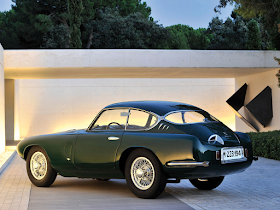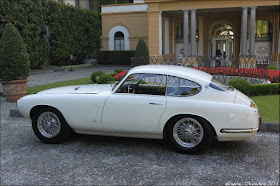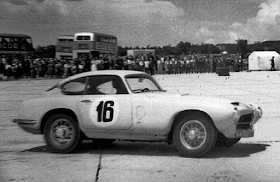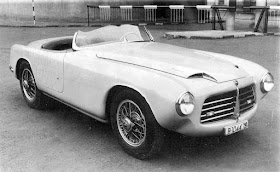Pegaso made the Z-102 starting in 1951 and finishing in 1958 having built a total of 84 cars. The original design for the Z-102 was penned by Pegaso chief technical manager Wifredo Ricart, formerly chief engineer for Alfa Romeo.
The Z-102 employed racing-car technology in its chassis and alloy body. It was built by the government backed ENASA, short for Empresa Nacional de Autocamiones SA, in the remnants of the Hispano Suiza factory. The name Pegaso was derived from the Greek mythical creature Pegasus; a flying horse. Out of the 84 Z-102s, 28 were cabriolets while the rest were fixed roof coupés. The majority of Z-102s had bodies by Carrozzeria Touring (although early Z-102 units carry Pegaso-made bodies), but a handful of cars had bodies by other coachbuilders such as Saoutchik. French coachbuilder Saoutchik bodied 18 cars, 3 of which were convertibles, as well as one of the original prototypes. Coachbuilder Serra bodied a handful of cars as well. In house coachbuilder Enasa also built a version of the Z-102 called the "Cupola", Only two "Cupola" models were known to have been built. One of them survived.
The Z-102 employed racing-car technology in its chassis and alloy body. It was built by the government backed ENASA, short for Empresa Nacional de Autocamiones SA, in the remnants of the Hispano Suiza factory. The name Pegaso was derived from the Greek mythical creature Pegasus; a flying horse. Out of the 84 Z-102s, 28 were cabriolets while the rest were fixed roof coupés. The majority of Z-102s had bodies by Carrozzeria Touring (although early Z-102 units carry Pegaso-made bodies), but a handful of cars had bodies by other coachbuilders such as Saoutchik. French coachbuilder Saoutchik bodied 18 cars, 3 of which were convertibles, as well as one of the original prototypes. Coachbuilder Serra bodied a handful of cars as well. In house coachbuilder Enasa also built a version of the Z-102 called the "Cupola", Only two "Cupola" models were known to have been built. One of them survived.
The Z102 entered production with a 2.5 (2472cc) litre engine as used in the prototypes, though later there were variants with 2.8 (2816cc), and 3.2 (3178cc) litre DOHC desmodromic 32-valve V8 360 hp (270 kW) engines with multiple carburetors or optional supercharger. Horsepower ranged from 175 to 360, and, transferred through a five-speed gearbox and gear-driven camshaft, the fastest could reach 155 mph (249 km/h), exceeding Ferrari autos.The base model had an 120 mph (192 km/h) top speed.
The Z-102 started life as two prototypes in 1951 as a coupe and a drophead (see below). The coupe and convertible had dumpy steel bodies, and weight was an issue to the extent that Pegaso made the decision to revert to alloy for the coachwork. Coachbuilder Touring then 'beautified' the design, replacing the grille with a two-piece cross, lowering the car, repositioning the foglights, and simplifying various details to give it a clean profile, similar to the contemporary Aston Martin DB2 and the Lancia Aurelia, that was the most memorable and numerous of all Z-102 bodies. (wikipedia, ultimatecarpage.com)
The Z-102 started life as two prototypes in 1951 as a coupe and a drophead (see below). The coupe and convertible had dumpy steel bodies, and weight was an issue to the extent that Pegaso made the decision to revert to alloy for the coachwork. Coachbuilder Touring then 'beautified' the design, replacing the grille with a two-piece cross, lowering the car, repositioning the foglights, and simplifying various details to give it a clean profile, similar to the contemporary Aston Martin DB2 and the Lancia Aurelia, that was the most memorable and numerous of all Z-102 bodies. (wikipedia, ultimatecarpage.com)
Series 1 Coupe
(Photos from rmsothebys.com, forumducavallino.nuxit.net,
ultimatecarpage.com, and classiccartrust.com)
1953 Pegaso Z102 BS 3.2 Touring Spyder
The racing version of the Z102. The road going chassis was already drilled for lightness so other than an engine little was needed. Touring fitted the racing cars with roadster bodies using their light weight 'superleggera' construction. In full running order the cars weighed less than 1000 kg. In September of 1953 a supercharged roadster was timed at 152 mph, a road car record. 3 units were made. (ultimatecarpage.com)
(Photos from ultimatecarpage.com)
1952 Pegaso Z-102 Berlinetta Superleggera Prototype
ENASA built coachwork.
(Photos from carstyling.ru)
1952 Pegaso Z-102 Spider 'Tibidabo' Touring
Z-102 Spider 'Tibidabo' (chassis: 150.0118) was the first Pegaso body penned by Formenti and made by the Carrozzeria Touring. The Tibidabo was unveiled at the Paris Motor Show in 1952. The “Pegaso lorry-look” grille design of that early styling exercise, shared only with her first Touring berlinetta sister, soon replaced by the characteristic ”cross” sported by later Pegaso bodies. (carstyling.ru)
(Photos from carstyling.ru)






























































































































